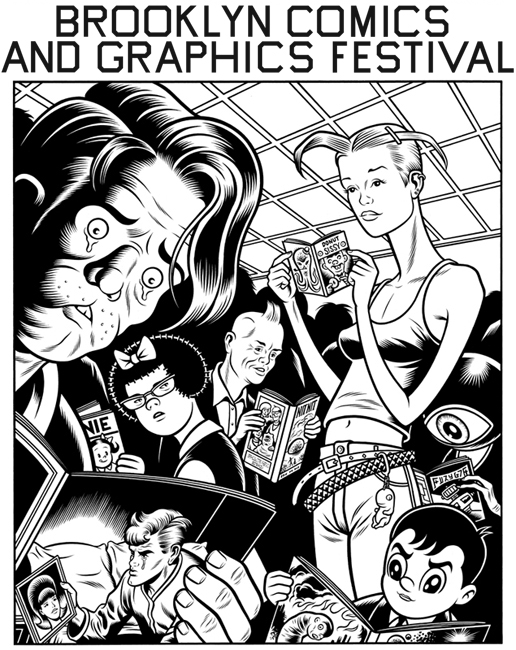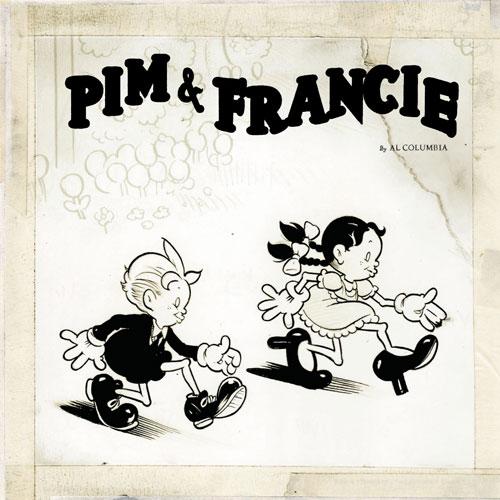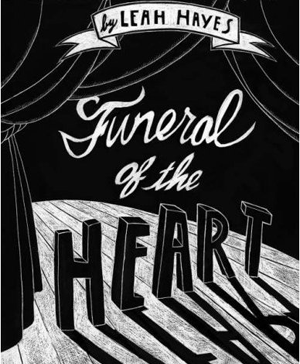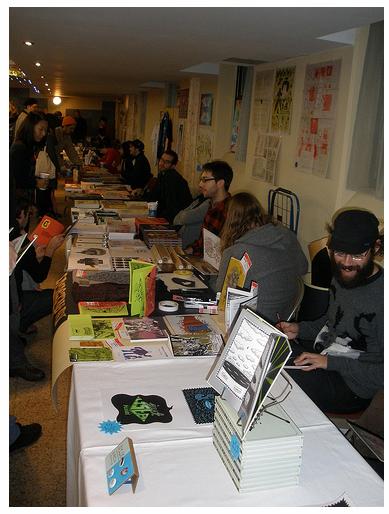
Three wisps of a line in a frame can communicate the speed of a character’s movement, the melancholy of a leaf floating to the ground, or, as in many cases, the sweet release of flatulence.
I grew up with bedtime stories straight from Betty and Veronica (my father did an amazing Big Moose voice), received the Maus box set for my 13th Christmas, and—as recommended by my then-beloved Sassy Magazine—in high school I dallied around with Love and Rockets. Besides a brief sensitive phase in college where I sped through and really felt Daniel Clowes and Chris Ware, I’m really not up on the contemporary comics scene. I’m unfamiliar with all of the artists (save one, Peter Saul) signing books and giving talks at the First Annual Brooklyn Comics and Graphics Festival. I’ve never heard of Charles Burns or Gary Panter, the stars, as I’ve been told, of the festival. This doesn’t mean I’m not interested, just generally uninformed. So I set out early to the festival, eager for an education.
Publisher Dan Nadel from PictureBox and Gabe Fowler, owner of the Brooklyn comic book store Desert Island organized the festival. Like Fowler’s store, the festival has a folksy handcrafted feel. In a church basement in Williamsburg, Christmas lights and paper decorations hang from the wooden rafters as individual comics artists and underground publishers display their wares. The word adorable quickly comes to mind, though it’s not quite right. What connotes this initial cuteness is the size of the fair (small) and the set-up (folding tables decorated by each seller). Also, everyone seems to be smiling and genuinely pleased to be there.
 So convivial might also be an apt adjective. The sense of self-importance that seemed to pervade the overgrown New York Art Book Fair held at PS1 in October is absent. In its place is a sort of keen earnestness—a freshness that I suppose could be linked to “the first annual” of the title. Creating an annual festival, one that reaches a very particular audience, such as comics fans, is an ambitious and far-reaching endeavor (the festival includes book signings, panel discussions, and bands slated to play late into the night). That it is so well received by this very audience feels good, almost chummy.
So convivial might also be an apt adjective. The sense of self-importance that seemed to pervade the overgrown New York Art Book Fair held at PS1 in October is absent. In its place is a sort of keen earnestness—a freshness that I suppose could be linked to “the first annual” of the title. Creating an annual festival, one that reaches a very particular audience, such as comics fans, is an ambitious and far-reaching endeavor (the festival includes book signings, panel discussions, and bands slated to play late into the night). That it is so well received by this very audience feels good, almost chummy.
The divide between artist and fan is non-existent as many artists set up their own tables or mill around, perusing the various books on display. The affable Noah Lyon (aka Retard Riot) explains that he started his now iconic cartoons in the early 90s by decorating the inserts to music tapes. Currently he produces a small booklet of mimeographed drawings every few months. The booklets I pick up display a frenetic absurdity in the form of hilarious loopy drawings, characters in “microwave oven pants,” and a carpet in “a different time zone.” Next to Lyons is the much more serious and young collective Uninhabitable Mansions. Their handmade books with silkscreen covers are almost precious in their careful designs. At their table they feature a new book for sale that just happens to be placed in the pocket of a trench coat, the very type of coat the villain in the story is always wearing. “How much is the book then?” I ask. “Oh we don’t know yet,” they reply.
 It might seem as if sales is not the main point of the festival (creating a community or dialogue being the point, perhaps), but people are certainly walking around with stacks of books under their arms. At the Desert Island table I fall hard for Al Columbia’s Pim and Francie, a book that uses an antiquated vernacular to tell the story of the perverse world of two 1930s styled characters. Pim innocently asks in one frame, “I wonder who could be leaving these cat heads all over the place?” Many people describe to me a mystery that surrounds Columbia. One man remarks that his enigmatic nature might make him “the Pink Floyd of the comic world.” Also of note is the darkly luscious Funeral of the Heart by Brooklyn illustrator and musician Leah Hayes (who plays music under the moniker Scary Mansion). Her flattened sketchy drawings create an elegiac quality of doom and gloom. A woman next to me exclaims, “Why do all of these have so much angst?!” Angst indeed, but Hayes taps into the best kind—lyric, truthful, heartbreaking.
It might seem as if sales is not the main point of the festival (creating a community or dialogue being the point, perhaps), but people are certainly walking around with stacks of books under their arms. At the Desert Island table I fall hard for Al Columbia’s Pim and Francie, a book that uses an antiquated vernacular to tell the story of the perverse world of two 1930s styled characters. Pim innocently asks in one frame, “I wonder who could be leaving these cat heads all over the place?” Many people describe to me a mystery that surrounds Columbia. One man remarks that his enigmatic nature might make him “the Pink Floyd of the comic world.” Also of note is the darkly luscious Funeral of the Heart by Brooklyn illustrator and musician Leah Hayes (who plays music under the moniker Scary Mansion). Her flattened sketchy drawings create an elegiac quality of doom and gloom. A woman next to me exclaims, “Why do all of these have so much angst?!” Angst indeed, but Hayes taps into the best kind—lyric, truthful, heartbreaking.
Steven Guarnaccia, Chair of the Illustration Department at Parsons, is generous in talking with me about the contemporary comics scene. He explains that while illustrators once created images to respond to a text given by a client, say a magazine or a newspaper, now more and more artists are creating their own texts. “When I came to the program around six years ago,” Guarnaccia says. “It was very clear that the most exciting stories were being generated by the artists themselves.” These visual narratives have since translated to a larger cultural realm as artists move beyond the comic book, creating toys and t-shirts, and often exhibiting prints in art galleries.
 On the train ride home I thumb through the small stapled-together books I purchased and wonder about comics. In one of my new favorites, Why Did I put this Town on my Face? Matt Wiegel tells the story of a man who moves a salt lick at night “a regular amount each time, so it’s like the days getting longer, or the moon’s phases.” Innocent deer are lured by the lick until it, and consequently the deer, finally approaches the Butcher Shop. There’s an economy to this doomed story that seems somehow linked to the inherent nature of the comic form. Three wisps of a line in a frame can communicate the speed of a character’s movement, the melancholy of a leaf floating to the ground, or, as in many cases, the sweet release of flatulence. It’s a densely abbreviated syntax that takes cues directly from its imagined context. Luckily, it is often a context we comics fans share, or at least relate to—never so much so as in that cozy church basement on a rainy cold Saturday.
On the train ride home I thumb through the small stapled-together books I purchased and wonder about comics. In one of my new favorites, Why Did I put this Town on my Face? Matt Wiegel tells the story of a man who moves a salt lick at night “a regular amount each time, so it’s like the days getting longer, or the moon’s phases.” Innocent deer are lured by the lick until it, and consequently the deer, finally approaches the Butcher Shop. There’s an economy to this doomed story that seems somehow linked to the inherent nature of the comic form. Three wisps of a line in a frame can communicate the speed of a character’s movement, the melancholy of a leaf floating to the ground, or, as in many cases, the sweet release of flatulence. It’s a densely abbreviated syntax that takes cues directly from its imagined context. Luckily, it is often a context we comics fans share, or at least relate to—never so much so as in that cozy church basement on a rainy cold Saturday.




